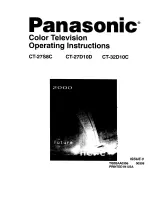
geometric processing, is transmitted from (47) and (46) of N201 to (1) and (2) of field
output circuit N301. The external resistor R258 (39K ) of N201 (52) provides a
reference current to the field tooth wave generator. The external capacitor C233 (104) of
(51) forms a capacitor for the field tooth wave. The field output integrated circuit N301 is
a complete bridge current drive output circuit, the field deflection coil is installed in the
center of the output amplifier. The positive and negative tooth wave signals from (47) and
(46) of N201 are input to (1) and (2) of N301, and then output from (9) and (5) after
shaping and amplifying in TDA8350Q. R301 (3 K
¦¸
) transfers input current into voltage,
which compares with the voltage generated by the field scan current flowing through
R302 (1.5
¦¸
) and R303 (1.5
¦¸
) total parallel resistance, and functions as the feedback
voltage of TDA8350Q to alter the field output current by altering R301. Power supply for
TDA8350Q is realized by dual power sources, and the forward and return power sources
are +16.5V and +46V, obtained from the return pulse which is rectified, filtered and then
transmitted by the line output transformer T444.
Information introducing functions and testing data for TDA8350Q maintenance is listed in
Table 4. Test information is listed beneath VHFL, if a cylindrical color card is installed
then a FLUKE 79 III meter is used.
8. Analysis of line sync and line scan output circuits
As the line oscillation circuit is installed inside N201 (TDA8844), external line oscillation
components are not necessary while the oscillation frequency is controlled by PH1 tester.
Some brightness signals including compound sync signals are transmitted to the internal
sync segregation circuits, where line sync and field sync pulses are segregated. The line
sync pulse signals are transmitted to PH1 tester which functions to keep oscillation and
input signal frequencies synchronic. C249 (472), R255 (15K
¦¸
) and C241 (lu) connected
to N201 (43) are phaselock loop filters. The line oscillation signals corrected by PH1
tester are transmitted to PH2 tester, which functions to stabilize and control the phase
positions of output line pumping pulse and to ensure consistent line linearity and
Table 5
Grounding Resistance (R)
No.
Function
Working
Voltage
(V)
Positive
(
¦¸
)
Negative
(
¦¸
)
1
Field pumping signal positive
input VDP
2.3
67.0K
67.3K
2
Field pumping signal negative
input VDN
2.2
69.9K
70.3K
3
Feedback
8.3
5.9K
5.9K
4
Supply voltage
16.9
6.4M
2.4M
5
Output voltage B
8.2
6.4K
6.1K
6
Neutral point
0
~
~
7
Grounding
0
0
0
8
Return supply voltage
48.8
32.5K
25.5K
9
Output voltage A
8.6
5.9K
6.1K
10 Neutral point
0.9
~
4.1M
11 E-W correction signal output
11.1
10.4K
10.1K
12 E-W correction signal input
0.73
62.5K
62.9K
13 Grounding
0
0
0
21
















































